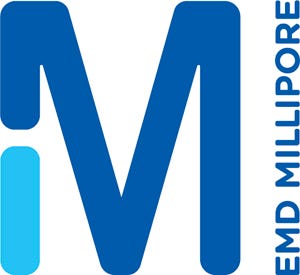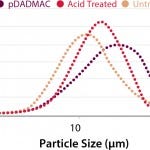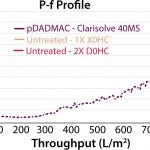- Sponsored Content
pDADMAC Flocculant Reagent for Use with Clarisolve® Depth FilterspDADMAC Flocculant Reagent for Use with Clarisolve® Depth Filters

Advances in cell line engineering and media design have allowed for improvements in monoclonal antibody expression, with cell culture systems exhibiting product titers >10 g/L. These high-density cell cultures pose a great challenge in the use of existing solid liquid separation techniques because of the need to remove larger amounts of biomass and the increase in submicron particles. In addition, the increased level of soluble impurities introduces new bottlenecks for chromatographic processing because of the increased levels of contaminants from cell debris generated during cell culture and harvesting.

FIGURE 1: Particle-size distribution (PSD) of a representative CHO cell culture feed stream (MAb05). Data are shown for unadjusted (pH 7.0), acid treated (pH 4.8), and pDADMAC (0.0375%) treated cell culture feed streams.
The use of flocculation in harvest is a way to overcome these challenges. Controlled flocculation of cell culture suspensions can be used to enhance clarification throughput and downstream filtration operations. We have developed a purified poly (diallyldimthyl-ammonium chloride) (pDADMAC) cationic flocculant reagent targeted for biopharmaceutical applications, which will enhance clarification and downstream filtration operations. pDADMAC improves the removal of contaminants by driving the charged flocculation of the negatively charged entities. Upon addition to the cell-culture feed stream in a concentration between 0.025 and 0.075% (w/v), it rapidly flocculates the negatively charged cells and cellular debris into larger particles by means of an ionic interaction mechanism.
This, compared with untreated feed streams, provides a significantly higher harvest throughput when using Clarisolve® depth filters. The Clarisolve® depth filters product range offers a solution for primary clarification of pretreated feed streams. They feature a gradient density structure specifically designed to the particle-size distribution of pretreated feed streams and are available in 20-, 40-, and 60-m pore diameters.

FIGURE 2: Throughput comparison studies on the Clarisolve® filters with CHO cell culture feed stream (MAb05). Data are shown for unadjusted (pH 7.0) D0HC/X0HC and pDADMAC (0.0375%) 40MS treated cell culture feed streams.
With improved volumetric capacity and reduced turbidity over currently available depth filters, the clarification step of pretreated feeds can be processed in a significantly reduced footprint without the need for a secondary stage of clarification.
The data from Clarisolve® depth filters with pDADMAC flocculant pretreatment demonstrate a significant improvement in filtration efficiency, including a reduction in supernatant turbidity and improved volumetric throughput compared with conventional filters. The purification process removes residual polymer to a concentration
Nripen Singh, PhD, is senior research scientist at EMD Millipore. For information, contact Michael Peck, development engineer at EMD Millipore, 80 Ashby Road, Bedford, MA 01730; 1-781-533-2350; [email protected]; www.emdmillipore.com
You May Also Like





